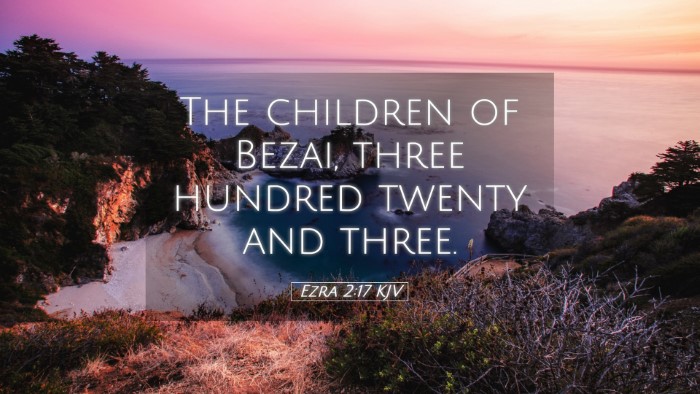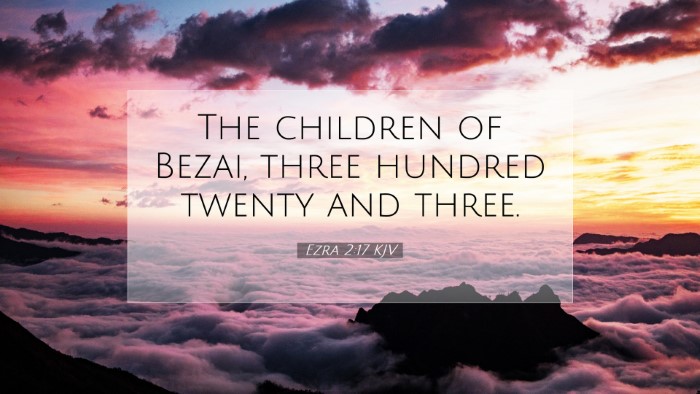Commentary on Ezra 2:17
Ezra 2:17 states: "And the children of Ezer, the children of Harim, and the children of Pahathmoab, of the children of Jeshua and Joab, two thousand eight hundred and twelve." This verse lists part of the returning exiles who came back to Jerusalem from Babylonian captivity.
Contextual Overview
The book of Ezra recounts the return of the Jewish people to their homeland after a prolonged exile. Following the edict of Cyrus, which allowed the Jews to return, the chapter enumerates those who returned with Zerubbabel. Through meticulous counting, the narrative seeks to establish a true representation of the returning community, emphasizing both the spiritual and communal restoration.
Insights from Commentaries
Matthew Henry:
Henry emphasizes the importance of the genealogical records in this verse. He notes that such lists serve not only to remind the people of their heritage but also to show the fulfillment of God's promise to restore Israel. He draws attention to the families mentioned, particularly the children of Ezer and Harim, highlighting their roles and contributions during the rebuilding process.
Albert Barnes:
Barnes illuminates the significance of the numerical count, noting that the number of 2,812 represents a significant portion of the community. Each family and their descendants played a role in the restoration of Jerusalem. He posits that this descent was akin to a divine appointment, demonstrating how God meticulously oversees the restoration of His people. The families mentioned are noteworthy for their service in both civic and religious functions upon their return.
Adam Clarke:
Clarke aligns with the theme of restoration but provides further detail on the families themselves. He discusses the historical context of Ezer and Harim, noting that these clans would have had unique roles in the cultural and religious revival of post-exilic Israel. Clarke also comments on the dual names, suggesting it could refer to notable leaders or communities that may have had alternate identities over time. His analysis reflects a broader understanding of identity and continuity amid cultural disruption.
Theological Implications
The verse serves as a reminder of God’s faithfulness to His covenant people. The careful recording of names signified more than mere numerics; it highlighted individual and collective identity restored through grace. This could be particularly meaningful for pastors and theologians in understanding the concept of communal restoration and the significance of remembering one's heritage in faith.
Key Themes
- Genealogy and Identity: Highlighting the connection of the returning exiles to their ancestors speaks volumes about the importance of identity shaped by history and faith.
- Faithfulness of God: The return underscores God's promises; it reveals a God who remembers His people and delivers them at the appointed time.
- Role of Community: The emphasis on families denotes the role that community played in the structure of Jewish life and worship. Pastors may find this insight pertinent when ministering to modern congregations.
Applications for Today
Pastors, students, and scholars may extract several key applications from this verse:
- Value of Historical Awareness: Understanding the past can inform present and future actions in ministry and community involvement.
- Restoration Practices: Exploring how communities can rebuild after periods of struggle can draw parallels with the returning exiles.
- Communal Identity in Christ: Just as the returning families found strength in their collective identity, believers today find strength in their unity in Christ.
Conclusion
In conclusion, Ezra 2:17 depicts a pivotal moment in the history of Israel, capturing not only a census of those returning but also the heartbeat of restoration through God’s grace. By examining this verse through the lenses of various commentaries, one grasp a deeper understanding of the interplay between history, theology, and communal identity. As such, it holds profound insights for contemporary believers engaged in the journey of faith.


